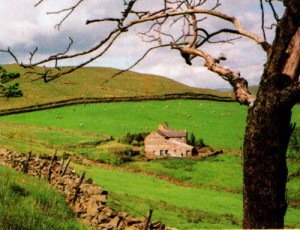
I was lucky. Born a Westmerian, I spent my youth roaming the South Westmorland fells and making forays into the neighbouring counties ofYorkshire and Lancashire.
I remember those terrific summer days in the late 1940s. We would make the circuit of Brownthwaite from Kirkby Lonsdale, on the fell road above Smithy House, past Gale Garth to Bull Pot accompanied by our father, who was the fount of all knowledge. The limestone plateau below beckoned like a siren. Somewhere up there, on the top of Barbon High Fell, was the Comer Stone, meeting place of the three counties. I knew that because I had just acquired my first OS map, and I itched to go there. The real magnet, though, was the line of trees that snaked its way across the plateau below, a place which the map informed me was Easegill Kirk. Skylarks trilled above and somewhere down there a cuckoo uttered its repetitive cry.
No, of course we weren’t the first to discover Easegill, but when my brother and I got ourselves organised we did find it for ourselves! What a find it was, too, its limestone gorge showing all the features of a dried-up river bed. There were abandoned waterfalls to climb, and caves, where young owls slept under the canopy of trees that clung to impossible rock faces. In one of the caves there was a mountainous white horse – well,
it was only a stalactite, but panic almost took over before I worked that out. An underground passage led up from the Kirk to the top of a defunct waterfall that we would have found impossible to climb. Out on the plateau there were potholes with sinister names like Lost John’s and Death’s Head Hole that drew us to look down into their black depths.
I went there recently on a journey down memory lane. To all appearances not much has changed. Smithy House and Gale Garth are well-kept and still inhabited, but Bull Pot is now the home of the Red Rose Pot Holing Club. The heather on the plateau was purple and I could hear that peculiar, almost human “Gabak!, Gabak!” cry of the grouse and the distant plaintive call of a curlew. I suppose the grouse shoots in autumn still go on, but I’ll bet the beaters take home a litde more than the ten shillings and a botde of beer that we young village lads rated just after the war. The gamekeeper was an old man of, oh, forty, I guess, but he could walk the legs off any of us. He would shout furious instructions from his key centre position.
“Hold hard on the left/right”, depending on which flank was racing ahead. These instructions were liberally spiced with expletives that do not require repetition here.
I recalled, too, hard winters that kept the farmers working round the clock to dig out their snow-bound sheep. It must have been a hard and lonely life up on the fell farms in those days.
I was gratified to discover, at Bull Pot, that the place I discovered so long ago now rates as a Site of Special Scientific Interest and enjoys a measure of protection from English Nature. It gave me great pleasure, too, to learn that the most extensive underground drainage system in the UK, and 11th in the world, is located not in the Yorkshire Dales, but is shared by Lancashire and that part of Cumbria that once was Westmorland.
Bill Macfarlane








